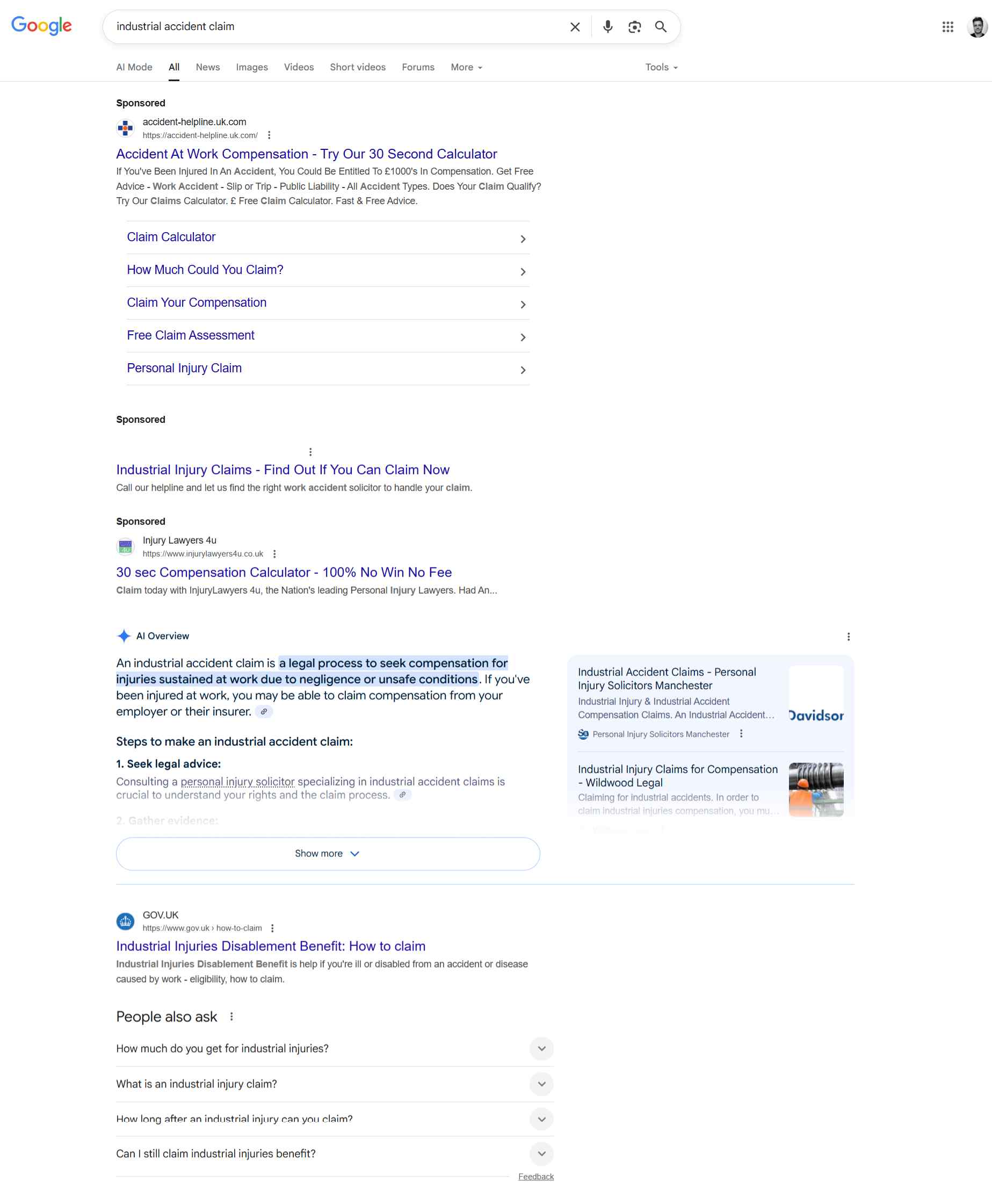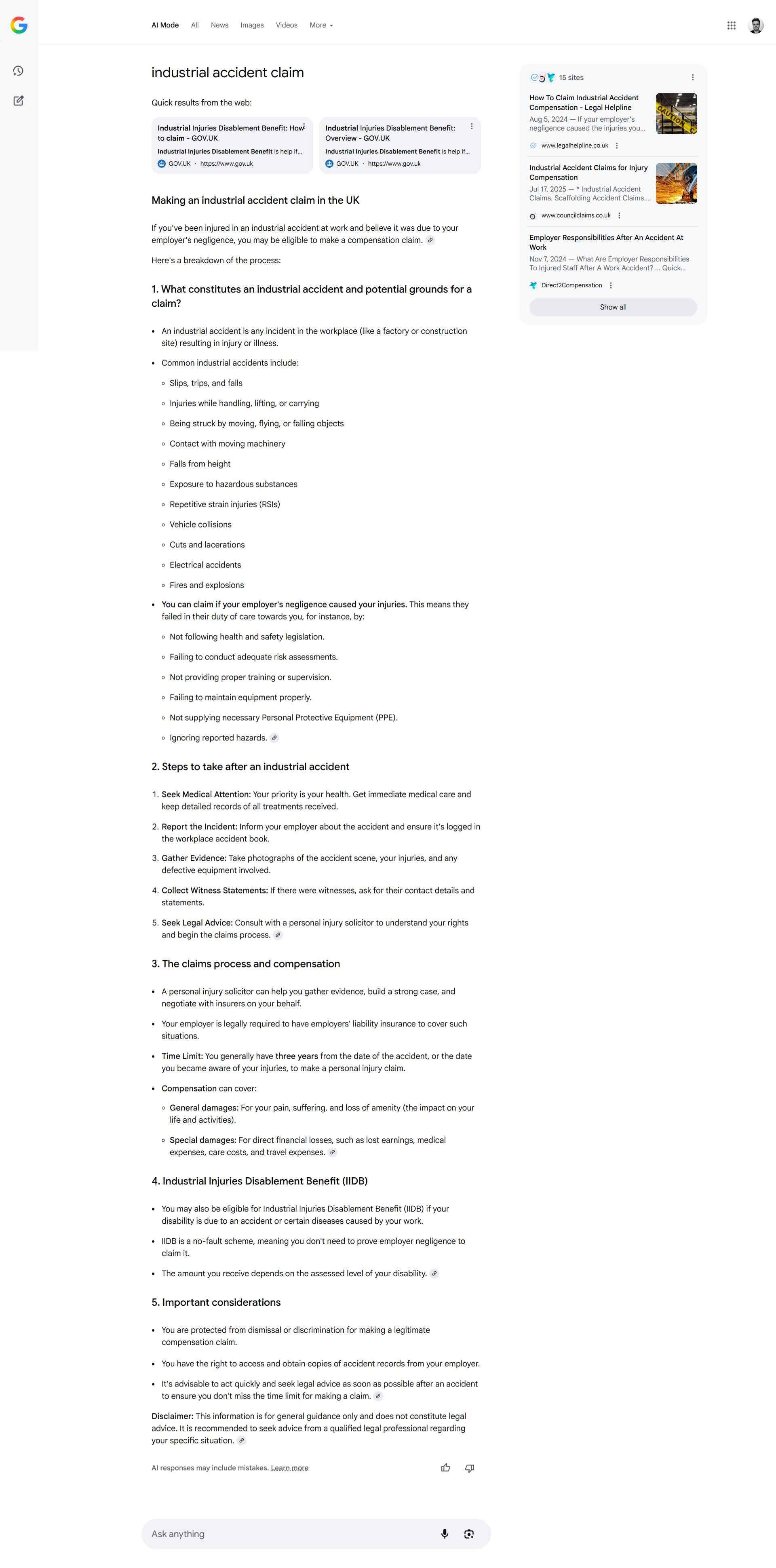Google Launches AI Mode in the UK – What It Means for SEO

Google has quietly rolled out a new search feature in the UK: AI Mode. It appears as a tab to the left of the familiar “All” tab – subtle, but deliberately placed to catch the eye. While “All” shows the classic SERP (ads, blue links, maps), AI Mode surfaces an AI‑generated overview with three supporting links in a sidebar.
Aside from a brief blog post and the usual industry press coverage, there’s been little fanfare or onboarding. I only noticed it while testing SERPs for the term “Industrial Accident Claim“.
One thing we know for certain: This is Google AI-Mode’s first real contact with the market – they’ll be watching closely to see how people respond.
Classic SERP vs AI Mode – Two Different Intents
The contrast between the two tabs is stark.
Classic SERP (All tab):
- PPC ads dominate above the fold.
- Organic results mix government information with hard‑sell solicitor landing pages.
- The user journey assumes “I want to make a claim now” – transactional intent.

AI Mode:
- The AI summary explains what qualifies as an industrial accident, employer duties, and the claims process.
- Two listings labelled as ‘quick results’ directly below the search-input field, and three sidebar links (a repeating fixture – an ‘AI Mode 3-pack’) favour trusted or explanatory sources (GOV.UK, law societies) over aggressive conversion pages.
- The journey assumes “I want to understand this before I act” – informational intent.

This isn’t just a new UI – it’s a different lens on search intent, which raises the real strategic question: where should authority flow?
Why Would Google Do This?
Two reasons stand out.
1. Legal and reputational risk
Personal injury claims fall under Your Money or Your Life (YMYL) categories. Sending users directly to commercial pages is risky – bad advice could mean lawsuits or reputational harm. A neutral, AI‑generated summary anchored to government or legal sources mitigates that.
2. Data gathering
By isolating AI Mode in its own tab, Google can quietly test adoption:
- How many users notice it?
- What do they click?
- Do they toggle back to Classic results?
- Does satisfaction rise or fall?
Google is essentially asking: do people even want this experience?
The Incentive Problem
Google’s business runs on ads. AI Mode shows none.
- If AI Mode gains traction, ad impressions (and revenue) drop.
- If Google floods it with ads, user trust drops.
High‑CPC queries like legal or finance keep the “All” tab relevant – Classic SERPs are monetisable, AI Mode currently isn’t.
Until Google solves that monetisation puzzle, it’s unlikely to default users into AI Mode for commercial searches.
Will Users Even Adopt It?
That’s the other unknown. Most people have 20 years of muscle memory: type query → click blue link.
AI Mode is cognitively heavier: summaries, sidebars, panels. It’s also branded “AI Mode” – tech‑ish, even intimidating for some. Many users distrust AI or see it as “big tech stealing data”.
For mass adoption, Google may need to rebrand: “Chat-Mode” or “Google-Chat” feels friendlier than “AI Mode”.
Right now, this looks like a live experiment – not a revolution.
The Split in Organic Search
What AI Mode really signals is a split:
- Informational, top‑of‑funnel search is migrating to AI Mode.
- Transactional, bottom‑funnel search remains in Classic SERPs (and monetised by ads).
For most businesses, that split forces a choice: where do you channel authority?
Publishers and aggregators might chase AI Mode visibility. However, if you sell products or services, the play is clear: bottom‑funnel. That’s where clicks and conversions still happen – and where Google has the strongest incentive to preserve traffic.
The Sovereign SEO Lens: Authority as Capital
This is where Machine Experience comes in.
Authority is finite capital. Every backlink you earn flows into a system – your MX Engine – that redistributes it through internal links, navigation, and structure. That engine decides which pages grow strong and which stay weak.
- Today: route capital to bottom‑funnel pages (service, product, conversion). They still rank in Classic SERPs, where monetisation lives.
- Tomorrow: if AI Mode evolves to serve high‑intent queries, those same pages become the new battleground – an ‘AI Mode 3‑pack’ instead of ten blue links. If your authority is already concentrated there, you’ll be ready.
Chasing AI Mode for informational pages is a trap: no clicks, high volatility, low ROI. Authority poured into top‑funnel content dilutes your ability to win where it matters.
Debunking “AI Mode Optimisation”
Expect vendors to start pitching “AI Mode SEO” alongside the rest (AIO, GEO, AEO) – endless informational content to chase inclusion in the sidebar 3-pack. It sounds innovative, but the economics don’t work:
- The 3‑pack varies constantly between users – no stable ranking to optimise.
- Click intent is low – summaries answer the query without needing a click.
- Capital allocated to informational pages starves converting pages.
Optimising for AI Mode right now isn’t strategy – it’s misallocation.
Three Possible Futures
Where could this go? A few plausible scenarios:
1. Quiet Kill
Adoption is low, Google shelves it quietly. Classic SERPs remain dominant; bottom‑funnel SEO wins.
2. Hybrid Co‑Existence
AI Mode remains a separate tab, appearing or disappearing based on query intent – similar to how Maps or News surfaces. “All” stays default and monetised, while AI Mode handles informational queries in parallel. MX strategy still doesn’t change: authority continues to flow to high‑intent pages.
3. AI‑First Pivot
Google doubles down. AI Mode becomes default, even for commercial queries. The 3‑pack replaces ten blue links – competition intensifies. Only concentrated authority survives.
Takeaway
AI Mode doesn’t kill SEO – it fragments it. Informational search shifts to AI Mode; transactional search remains defensible and monetised.
Google has been sitting on AI tech for years. If they believed it was the future of search, they’d have rolled it out long before now. They didn’t – because it threatened their ad model and they weren’t sure it improved the experience.
The rise of ChatGPT forced their hand.
AI Mode looks like a defensive play: claw back top‑of‑funnel queries drifting to LLMs without cannibalising the revenue they get from transactional search. That’s why a hybrid coexistence is the most likely outcome – “All” stays ad‑monetised and dominant, while AI Mode appears for informational queries when Google thinks it helps.
The strategic question isn’t “how do we optimise for AI Mode?” – it’s where do we allocate authority?
For most businesses, the answer is clear: bottom‑funnel or bust. Build MX Engines that route capital to your highest‑yield pages. That covers you now – and positions you for whatever Google does next.
This is what Sovereign SEO was built for.
Get in touch to see how a Sovereign SEO strategy can put your most important pages ahead of the competition.